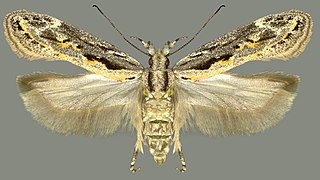
Gelechioidea is the superfamily of moths that contains the case-bearers, twirler moths, and relatives, also simply called curved-horn moths or gelechioid moths. It is a large and poorly understood '"micromoth" superfamily, constituting one of the basal lineages of the Ditrysia.

Bryotropha is a genus of the twirler moth family (Gelechiidae). Among these, it is placed in the tribe Anomologini of subfamily Gelechiinae; the tribe was formerly considered a distinct subfamily Anomologinae.

Isophrictis is a genus of moths in the family Gelechiidae.

Metzneria is a genus of moths in the family Gelechiidae, described by Philipp Christoph Zeller in 1839.

Monochroa is a genus of moths in the family Gelechiidae.
Ornativalva is a genus of moths in the family Gelechiidae.
Parapodia is a monotypic moth genus in the family Gelechiidae described by Joseph de Joannis in 1859. It contains the species Parapodia sinaica, described by Georg Ritter von Frauenfeld in 1859, which is found in Arabia, the Sinai desert, Palestine and southern France.
Tineomigma is a genus of moths belonging to the family Tineidae.

Ornativalva plutelliformis is a moth of the family Gelechiidae. It was described by Staudinger in 1859. It is found from southern Europe and North Africa east to western Asia and China (Xinjiang).
Amblypalpis tamaricella is a species of moth in the family Gelechiidae. It was described by Aleksandr Sergeievich Danilevsky in 1955. It is found in Central Asia, where it has been recorded from Kazakhstan and western China. The habitat consists of riparian forests and deserts.

Anomologinae is a subfamily of moths in the family Gelechiidae.
Megacraspedus serica is a moth of the family Gelechiidae. It was described by Edward Meyrick in 1909. It is found in South Africa.
Ornativalva ornatella is a moth of the family Gelechiidae. It was described by Sattler in 1967. It is found in Romania, the southern part of European Russia, Turkey, Iran, Afghanistan and Mongolia.
Ornativalva pharaonis is a moth of the family Gelechiidae. It was described by Sattler in 1967. It is found in Tunisia, Libya, Egypt, Sudan and Israel.
Ornativalva indica is a moth of the family Gelechiidae. It was described by Sattler in 1967. It is found in southern Iran (Luristan), Pakistan (Peshawar) and India (Bihar).
Ornativalva zonella is a moth of the family Gelechiidae. It was described by Pierre Chrétien in 1917. It is found in Algeria, Tunisia, Israel, Saudi Arabia, southern Iran and China (Xinjiang).
Ornativalva kalahariensis is a moth of the family Gelechiidae. It was described by Anthonie Johannes Theodorus Janse in 1960. It is found in Namibia and South Africa.
Ornativalva antipyramis is a moth of the family Gelechiidae. It was described by Edward Meyrick in 1925. It is found on the Cape Verde islands, the Canary Islands, as well as in Morocco, Algeria, Tunisia, Libya, Egypt, Sudan, Yemen (Socotra), Jordan, Saudi Arabia, southern Iran (Luristan) and Pakistan.
Ornativalva mixolitha is a moth of the family Gelechiidae. It was described by Edward Meyrick in 1918. It is found in Morocco, Algeria, Tunisia, southern Russia, Turkey, Sudan, Iraq, Iran, Afghanistan, Pakistan, India (Bihar) and Mongolia.
Ornativalva angulatella is a moth of the family Gelechiidae. It was described by Pierre Chrétien in 1915. It is found in Algeria and Tunisia.





